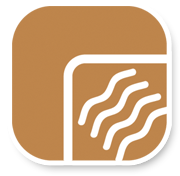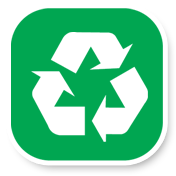Click on product above & see how we compare!
EPDM
Ethylene Propylene Diene Monomer
ADVANTAGES
- Initial low maintenance.
- ADA/Wheelchair accessible.
- Totally seamless surface.
- Water permeable surface allowing water to drain completely through.
- Designs/Logos can be incorporated into the play surface adding play value.
- Can be installed over a hard base or crushed stone base.
DISADVANTAGES
- Wide variations in quality of materials.
- Sunlight (U.V.) changes physical properties of the system and will make the granular hard and brittle.
- Colors fade/discolor rapidly.
- High maintenance.
- After 1-3 years, EPDM systems lose their impact attenuation properties causing failure to meet ASTM F1292 standards.
- Requires professional installation.
- EPDM rubber becomes worn and brittle over time creating tears and loose rubber particles.
- Due to color fading, repairs are easily noticeable.
- Loose rubber particles can make the surface slippery.
- Worn areas create tripping hazards.
- To keep the cost low, many EPDM surfaces use black in the mix which makes surface temperatures become very hot.
- High installation costs.
- SBR buffing used in the cushioned layer have been found to contain harmful chemicals.
“TPV”
Ethylene Propylene Rubber
ADVANTAGES
- Low maintenance.
- ADA/Wheelchair accessible.
- Totally seamless surface.
- Water permeable surface allowing water to drain completely through.
- Designs/Logos can be incorporated into the play surface adding play value.
- Can be installed over a hard base or crushed stone base.
- Better U.V. stability than EPDM.
DISADVANTAGES
- Rosehill TPV is only marketed as a Thermoplastic Vulcanized Rubber.
There are no thermoplastic characteristics and it is not a true thermoplastic rubber.
- Variety in quality of materials.
- Single component aliphatic and aromatic binders used depending on installer.
- High installation costs.
- SBR buffing used in the cushioned layer have been found to contain harmful chemicals.
EWF
Engineered Wood Fiber
ADVANTAGES
- Fairly Durable.
- ADA/Wheelchair accessible (when properly maintained).
- Low initial cost.
- Easy to obtain.
- Natural appearance.
DISADVANTAGES
- Decomposes and compresses over time.
- Attracts fungus and microbial grown when wet/damp.
- High humidity and freezing temperatures can reduce its effectiveness. *Due to moisture freezing throughout the surface, engineered wood fiber should not be used in cold weather.
- High maintenance.
- Can easily be displaced to areas outside of the play area.
- Parents report that children pick it up to play with or put it in their mouth.
- Can cause splinters.
- Raking is required under wear areas to keep the proper system depth.
- The depth should be inspected on a regular basis to ensure the surface meets ASTM F1292.
- Wood Fiber will need to be topped off every 1-3 years.
- Can conceal animal excrement or dangerous sharp items.
- Conditions could occur that may be prevalent for weed growth.
- Flammable.
- Limited design options.
- Studies by the National Center of Accessibility (NCA) found that playground sites with engineered wood fiber require "greater work force needed to move across the surface".
Rubber Mulch
ADVANTAGES
- Low cost.
- Eco-Friendly – Made with 100% recycled tires.
- Easy to install.
DISADVANTAGES
- Variety in quality, metal from tires may be left in some rubber mulch.
- Made from recycled tires containing carcinogens/toxic chemicals.
- Mostly black rubber, creating a hot surface in warmer climates.
- High maintenance.
- Can easily be displaced to areas outside the play area.
- Raking is required under wear areas to ensure the proper depths are maintained.
- Surface should be inspected on a regular basis to ensure the depth of the surface meets ASTM F1292.
- Highly flammable.
- Not effective at controlling weeds.
- In hot temperatures rubber mulch may smell and let off harmful fumes.
- Can conceal animal excrement or dangerous sharp items.
- Requires greater work force needed to move across the surface.





